Ziheng Zhang
Why Do Open-Source LLMs Struggle with Data Analysis? A Systematic Empirical Study
Jun 24, 2025Abstract:Large Language Models (LLMs) hold promise in automating data analysis tasks, yet open-source models face significant limitations in these kinds of reasoning-intensive scenarios. In this work, we investigate strategies to enhance the data analysis capabilities of open-source LLMs. By curating a seed dataset of diverse, realistic scenarios, we evaluate models across three dimensions: data understanding, code generation, and strategic planning. Our analysis reveals three key findings: (1) Strategic planning quality serves as the primary determinant of model performance; (2) Interaction design and task complexity significantly influence reasoning capabilities; (3) Data quality demonstrates a greater impact than diversity in achieving optimal performance. We leverage these insights to develop a data synthesis methodology, demonstrating significant improvements in open-source LLMs' analytical reasoning capabilities.
PADriver: Towards Personalized Autonomous Driving
May 08, 2025Abstract:In this paper, we propose PADriver, a novel closed-loop framework for personalized autonomous driving (PAD). Built upon Multi-modal Large Language Model (MLLM), PADriver takes streaming frames and personalized textual prompts as inputs. It autoaggressively performs scene understanding, danger level estimation and action decision. The predicted danger level reflects the risk of the potential action and provides an explicit reference for the final action, which corresponds to the preset personalized prompt. Moreover, we construct a closed-loop benchmark named PAD-Highway based on Highway-Env simulator to comprehensively evaluate the decision performance under traffic rules. The dataset contains 250 hours videos with high-quality annotation to facilitate the development of PAD behavior analysis. Experimental results on the constructed benchmark show that PADriver outperforms state-of-the-art approaches on different evaluation metrics, and enables various driving modes.
Not All Parameters Matter: Masking Diffusion Models for Enhancing Generation Ability
May 06, 2025
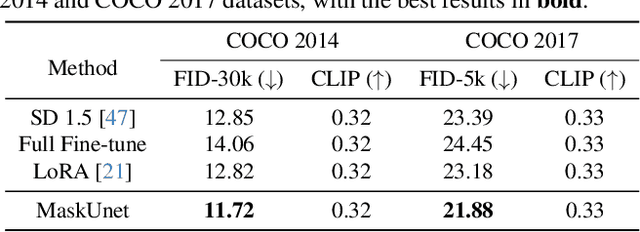
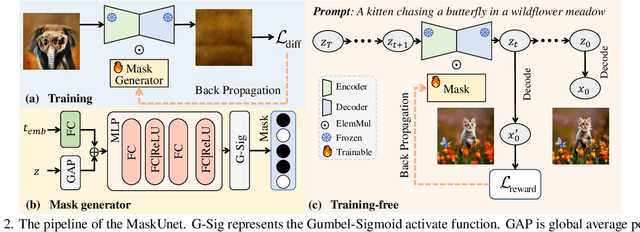
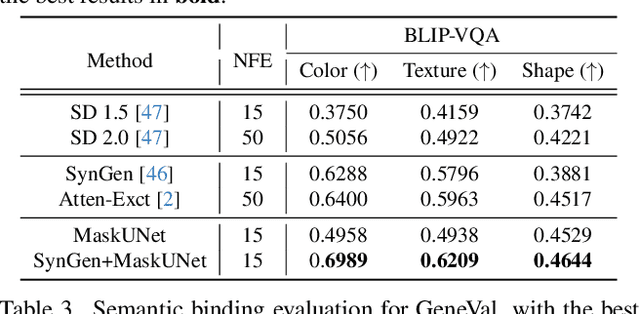
Abstract:The diffusion models, in early stages focus on constructing basic image structures, while the refined details, including local features and textures, are generated in later stages. Thus the same network layers are forced to learn both structural and textural information simultaneously, significantly differing from the traditional deep learning architectures (e.g., ResNet or GANs) which captures or generates the image semantic information at different layers. This difference inspires us to explore the time-wise diffusion models. We initially investigate the key contributions of the U-Net parameters to the denoising process and identify that properly zeroing out certain parameters (including large parameters) contributes to denoising, substantially improving the generation quality on the fly. Capitalizing on this discovery, we propose a simple yet effective method-termed ``MaskUNet''- that enhances generation quality with negligible parameter numbers. Our method fully leverages timestep- and sample-dependent effective U-Net parameters. To optimize MaskUNet, we offer two fine-tuning strategies: a training-based approach and a training-free approach, including tailored networks and optimization functions. In zero-shot inference on the COCO dataset, MaskUNet achieves the best FID score and further demonstrates its effectiveness in downstream task evaluations. Project page: https://gudaochangsheng.github.io/MaskUnet-Page/
DiT4SR: Taming Diffusion Transformer for Real-World Image Super-Resolution
Mar 30, 2025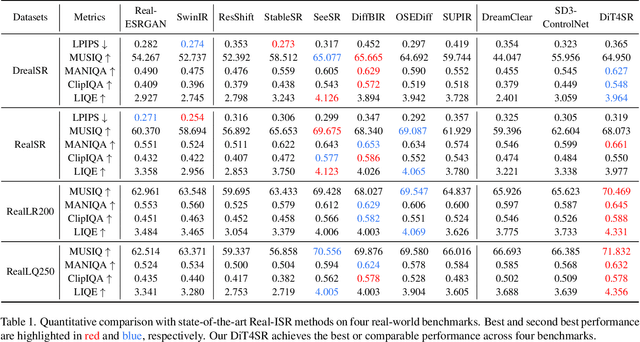
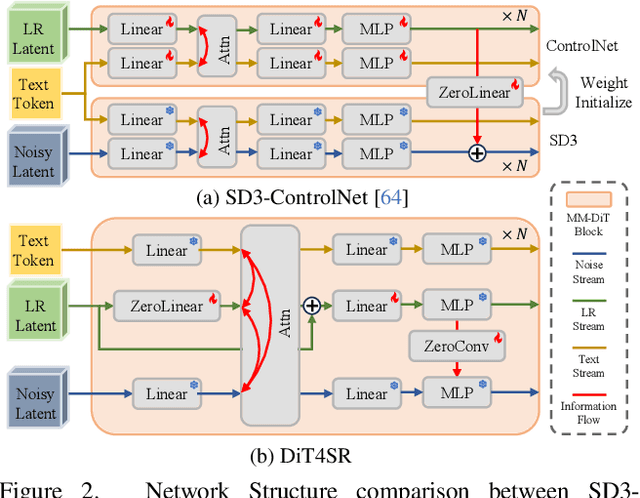

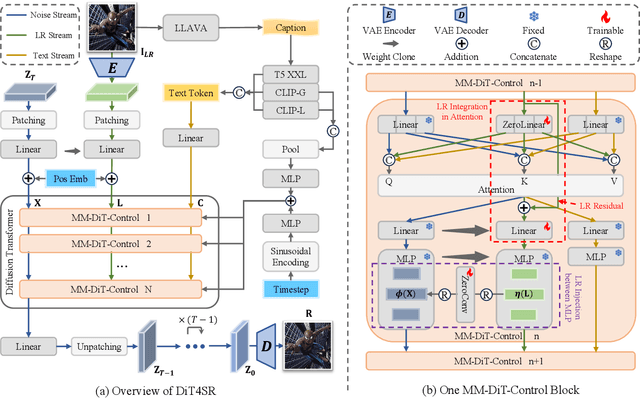
Abstract:Large-scale pre-trained diffusion models are becoming increasingly popular in solving the Real-World Image Super-Resolution (Real-ISR) problem because of their rich generative priors. The recent development of diffusion transformer (DiT) has witnessed overwhelming performance over the traditional UNet-based architecture in image generation, which also raises the question: Can we adopt the advanced DiT-based diffusion model for Real-ISR? To this end, we propose our DiT4SR, one of the pioneering works to tame the large-scale DiT model for Real-ISR. Instead of directly injecting embeddings extracted from low-resolution (LR) images like ControlNet, we integrate the LR embeddings into the original attention mechanism of DiT, allowing for the bidirectional flow of information between the LR latent and the generated latent. The sufficient interaction of these two streams allows the LR stream to evolve with the diffusion process, producing progressively refined guidance that better aligns with the generated latent at each diffusion step. Additionally, the LR guidance is injected into the generated latent via a cross-stream convolution layer, compensating for DiT's limited ability to capture local information. These simple but effective designs endow the DiT model with superior performance in Real-ISR, which is demonstrated by extensive experiments. Project Page: https://adam-duan.github.io/projects/dit4sr/.
Building Machine Learning Challenges for Anomaly Detection in Science
Mar 03, 2025Abstract:Scientific discoveries are often made by finding a pattern or object that was not predicted by the known rules of science. Oftentimes, these anomalous events or objects that do not conform to the norms are an indication that the rules of science governing the data are incomplete, and something new needs to be present to explain these unexpected outliers. The challenge of finding anomalies can be confounding since it requires codifying a complete knowledge of the known scientific behaviors and then projecting these known behaviors on the data to look for deviations. When utilizing machine learning, this presents a particular challenge since we require that the model not only understands scientific data perfectly but also recognizes when the data is inconsistent and out of the scope of its trained behavior. In this paper, we present three datasets aimed at developing machine learning-based anomaly detection for disparate scientific domains covering astrophysics, genomics, and polar science. We present the different datasets along with a scheme to make machine learning challenges around the three datasets findable, accessible, interoperable, and reusable (FAIR). Furthermore, we present an approach that generalizes to future machine learning challenges, enabling the possibility of large, more compute-intensive challenges that can ultimately lead to scientific discovery.
Pioneer: Physics-informed Riemannian Graph ODE for Entropy-increasing Dynamics
Feb 05, 2025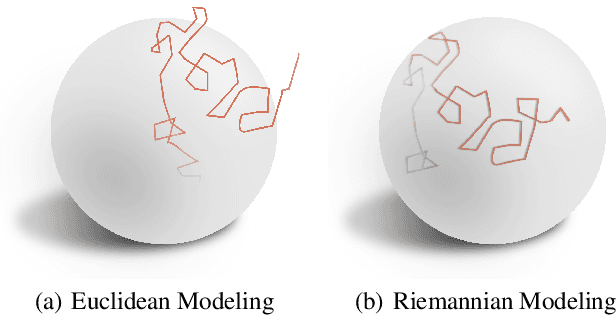

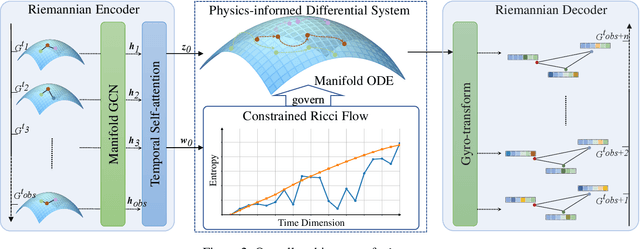
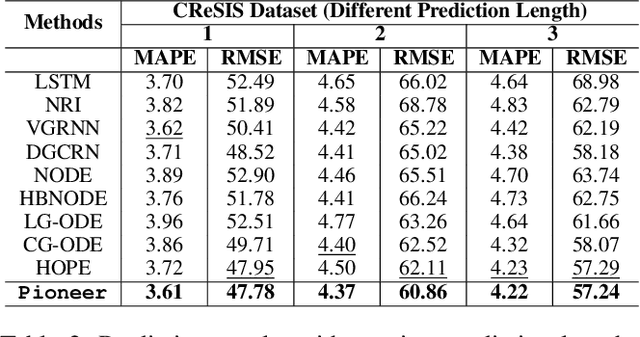
Abstract:Dynamic interacting system modeling is important for understanding and simulating real world systems. The system is typically described as a graph, where multiple objects dynamically interact with each other and evolve over time. In recent years, graph Ordinary Differential Equations (ODE) receive increasing research attentions. While achieving encouraging results, existing solutions prioritize the traditional Euclidean space, and neglect the intrinsic geometry of the system and physics laws, e.g., the principle of entropy increasing. The limitations above motivate us to rethink the system dynamics from a fresh perspective of Riemannian geometry, and pose a more realistic problem of physics-informed dynamic system modeling, considering the underlying geometry and physics law for the first time. In this paper, we present a novel physics-informed Riemannian graph ODE for a wide range of entropy-increasing dynamic systems (termed as Pioneer). In particular, we formulate a differential system on the Riemannian manifold, where a manifold-valued graph ODE is governed by the proposed constrained Ricci flow, and a manifold preserving Gyro-transform aware of system geometry. Theoretically, we report the provable entropy non-decreasing of our formulation, obeying the physics laws. Empirical results show the superiority of Pioneer on real datasets.
Finer-CAM: Spotting the Difference Reveals Finer Details for Visual Explanation
Jan 20, 2025



Abstract:Class activation map (CAM) has been widely used to highlight image regions that contribute to class predictions. Despite its simplicity and computational efficiency, CAM often struggles to identify discriminative regions that distinguish visually similar fine-grained classes. Prior efforts address this limitation by introducing more sophisticated explanation processes, but at the cost of extra complexity. In this paper, we propose Finer-CAM, a method that retains CAM's efficiency while achieving precise localization of discriminative regions. Our key insight is that the deficiency of CAM lies not in "how" it explains, but in "what" it explains}. Specifically, previous methods attempt to identify all cues contributing to the target class's logit value, which inadvertently also activates regions predictive of visually similar classes. By explicitly comparing the target class with similar classes and spotting their differences, Finer-CAM suppresses features shared with other classes and emphasizes the unique, discriminative details of the target class. Finer-CAM is easy to implement, compatible with various CAM methods, and can be extended to multi-modal models for accurate localization of specific concepts. Additionally, Finer-CAM allows adjustable comparison strength, enabling users to selectively highlight coarse object contours or fine discriminative details. Quantitatively, we show that masking out the top 5% of activated pixels by Finer-CAM results in a larger relative confidence drop compared to baselines. The source code and demo are available at https://github.com/Imageomics/Finer-CAM.
Prompt-CAM: A Simpler Interpretable Transformer for Fine-Grained Analysis
Jan 16, 2025



Abstract:We present a simple usage of pre-trained Vision Transformers (ViTs) for fine-grained analysis, aiming to identify and localize the traits that distinguish visually similar categories, such as different bird species or dog breeds. Pre-trained ViTs such as DINO have shown remarkable capabilities to extract localized, informative features. However, using saliency maps like Grad-CAM can hardly point out the traits: they often locate the whole object by a blurred, coarse heatmap, not traits. We propose a novel approach Prompt Class Attention Map (Prompt-CAM) to the rescue. Prompt-CAM learns class-specific prompts to a pre-trained ViT and uses the corresponding outputs for classification. To classify an image correctly, the true-class prompt must attend to the unique image patches not seen in other classes' images, i.e., traits. As such, the true class's multi-head attention maps reveal traits and their locations. Implementation-wise, Prompt-CAM is almost a free lunch by simply modifying the prediction head of Visual Prompt Tuning (VPT). This makes Prompt-CAM fairly easy to train and apply, sharply contrasting other interpretable methods that design specific models and training processes. It is even simpler than the recently published INterpretable TRansformer (INTR), whose encoder-decoder architecture prevents it from leveraging pre-trained ViTs. Extensive empirical studies on a dozen datasets from various domains (e.g., birds, fishes, insects, fungi, flowers, food, and cars) validate Prompt-CAM superior interpretation capability.
An Intra- and Cross-frame Topological Consistency Scheme for Semi-supervised Atherosclerotic Coronary Plaque Segmentation
Jan 14, 2025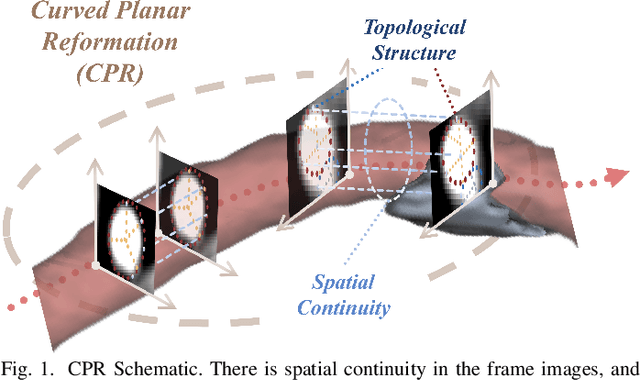

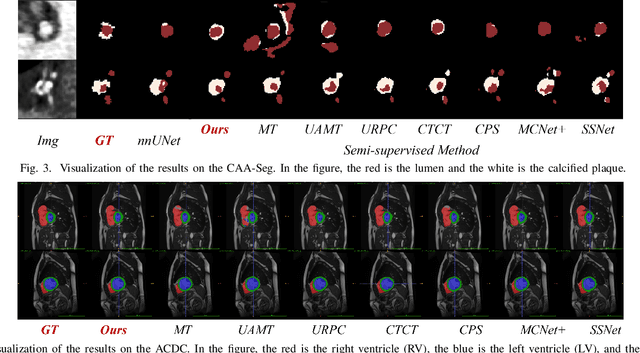
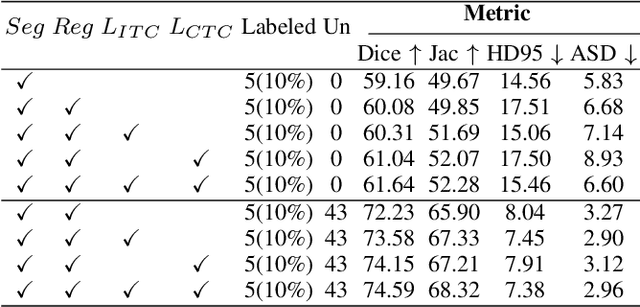
Abstract:Enhancing the precision of segmenting coronary atherosclerotic plaques from CT Angiography (CTA) images is pivotal for advanced Coronary Atherosclerosis Analysis (CAA), which distinctively relies on the analysis of vessel cross-section images reconstructed via Curved Planar Reformation. This task presents significant challenges due to the indistinct boundaries and structures of plaques and blood vessels, leading to the inadequate performance of current deep learning models, compounded by the inherent difficulty in annotating such complex data. To address these issues, we propose a novel dual-consistency semi-supervised framework that integrates Intra-frame Topological Consistency (ITC) and Cross-frame Topological Consistency (CTC) to leverage labeled and unlabeled data. ITC employs a dual-task network for simultaneous segmentation mask and Skeleton-aware Distance Transform (SDT) prediction, achieving similar prediction of topology structure through consistency constraint without additional annotations. Meanwhile, CTC utilizes an unsupervised estimator for analyzing pixel flow between skeletons and boundaries of adjacent frames, ensuring spatial continuity. Experiments on two CTA datasets show that our method surpasses existing semi-supervised methods and approaches the performance of supervised methods on CAA. In addition, our method also performs better than other methods on the ACDC dataset, demonstrating its generalization.
RoboGSim: A Real2Sim2Real Robotic Gaussian Splatting Simulator
Nov 18, 2024Abstract:Efficient acquisition of real-world embodied data has been increasingly critical. However, large-scale demonstrations captured by remote operation tend to take extremely high costs and fail to scale up the data size in an efficient manner. Sampling the episodes under a simulated environment is a promising way for large-scale collection while existing simulators fail to high-fidelity modeling on texture and physics. To address these limitations, we introduce the RoboGSim, a real2sim2real robotic simulator, powered by 3D Gaussian Splatting and the physics engine. RoboGSim mainly includes four parts: Gaussian Reconstructor, Digital Twins Builder, Scene Composer, and Interactive Engine. It can synthesize the simulated data with novel views, objects, trajectories, and scenes. RoboGSim also provides an online, reproducible, and safe evaluation for different manipulation policies. The real2sim and sim2real transfer experiments show a high consistency in the texture and physics. Moreover, the effectiveness of synthetic data is validated under the real-world manipulated tasks. We hope RoboGSim serves as a closed-loop simulator for fair comparison on policy learning. More information can be found on our project page https://robogsim.github.io/ .
 Add to Chrome
Add to Chrome Add to Firefox
Add to Firefox Add to Edge
Add to Edge